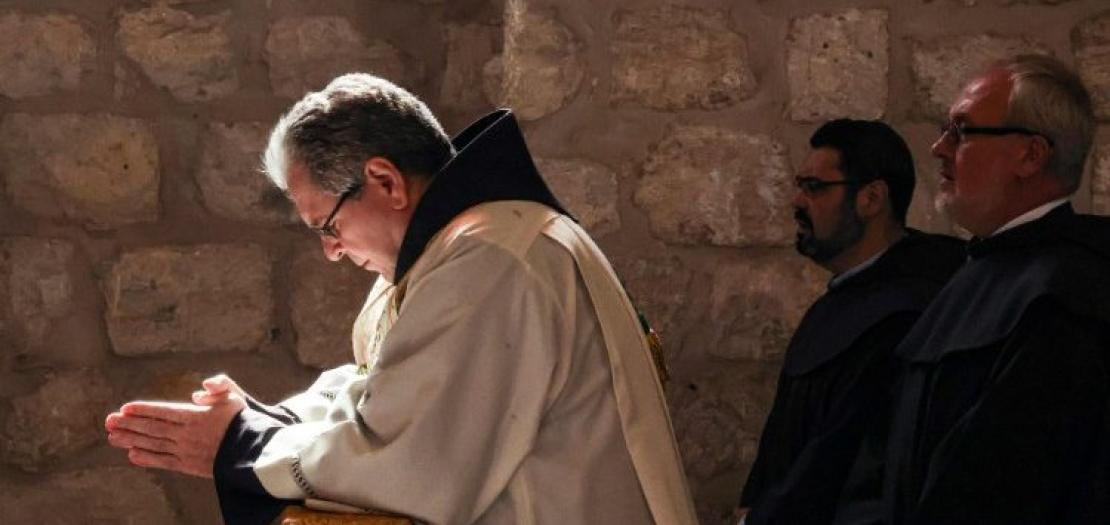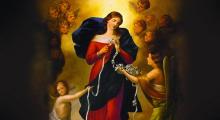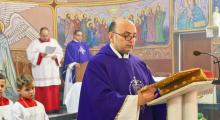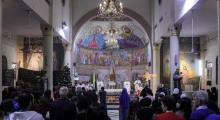Issued by the Catholic Center for Studies and Media - Jordan. Editor-in-chief Fr. Rif'at Bader - موقع أبونا abouna.org

Following is the text of an interview with Father Francesco Patton, Custos of the Holy Land on the current situation in the region, the life of Christians in the Holy Land today, future prospects, and Saint Francis’ legacy for the Knights and Dames of the Order.
When we think about the Christians in the Holy Land, we refer to them as the ‘living stones’ of this land. What kind of existence are these ‘stones’ experiencing today?
At the moment, there are no pilgrims coming to the Holy Land. The situation at present is like the one we experienced during the pandemic. Furthermore, there is the added difficulty of the West Bank being closed, so many of those who used to travel from Bethlehem to Jerusalem for work no longer are able to do so. Those who have retained the possibility to move -such as our school teachers-, have to have their fingerprints scanned at the checkpoint when entering and exiting. If by mistake they do not do so, they are deemed to not have complied with this procedure, and so are penalized.
We are therefore witnessing a situation in which Palestinians who live in the West Bank (including Christians) are mostly confined within that territory; in the case of Bethlehem, Christians in the area have lost their jobs because their livelihood depended on the pilgrimage industry. In Gaza, the few remaining parishioners are waiting for the end of the war, and then they will count how many of them are still alive. In addition, even in Israel, Israeli Arabs, including Christians who had integrated well into the social fabric –for example, in Galilee-, are experiencing tremendous difficulty at the moment with the deterioration of relations and concerns for security.
In the Holy Land, many Christians often have difficulty understanding the various ecclesial presences. Can you explain the different areas of responsibility and action of the Custody of the Holy Land and the Latin Patriarchate of Jerusalem and the collaborative relationship between the two?
Until 1847, the Custody was the sole presence in the Holy Land. When the Latin Patriarchate of Jerusalem was refounded, a distinction of roles was made. Episcopal functions belong to the Patriarch, and it is from him that directives for pastoral life originate. The Custos, on the other hand, is entrusted with the care of the Holy Places and the management of the status quo at the most important sanctuaries such as the Holy Sepulchre in Jerusalem and the Nativity in Bethlehem. This is done in collaboration with the Greek Orthodox Patriarchate and the Armenian Apostolic Patriarchate.
We must also remember the difference in jurisdiction. The Latin Patriarchate operates in Israel, Palestine, Jordan, and Cyprus, while the Custody has Syria, Lebanon, Egypt, Rhodes, and other territories too.
In addition, there are activities carried out by both the Patriarchate and the Custody, such as educational work through schools. The Custody has 18 schools throughout its territorial jurisdiction, including the oldest school in the Holy Land, which was founded in 1598 in Bethlehem. There are also parishes entrusted to us, including Nazareth, Bethlehem, Jerusalem, Jericho, and Akko. In these cases, therefore, a coordinated service must be carried out.
The Holy Land’s needs, and those of the Christian communities living there, are currently immense. How has the Custody been able to organize itself?
As you well know in the Order of the Holy Sepulcher, there are two sources of ecclesial sustenance for the Holy Land. The first is the Order, which is called upon to support the Latin Patriarchate of Jerusalem more directly; the second, the Colletta del Venerdì Santo [Good Friday Collection], is distributed 65% to the Custody and 35% to the Dicastery for the Eastern Churches. The Pro Terra Sancta collection –that was reformed in 1974 by Pope Paul VI with the Apostolic Exhortation Nobis in Animo- is indispensable for us. Pre-dating this, fund collections were permitted by the Holy Land Commissariats [Franciscan presences in over 60 countries that raise awareness about the Holy Land and seek support and solidarity for the Custody to continue its mission, Ed.]. This is because the Custody is not just a Franciscan order mission; instead, it has an official mandate from the Holy See, which, with the bull Gratias agimus of 1342, entrusted our Order with the care of the holy places, and from there, also the pastoral and socio-assistance commitment. Moreover, it is also thanks to the centuries-old pastoral commitment of the friars of the Custody that by the mid-1800s the conditions were created to re-establish the Latin Patriarchate of Jerusalem.
However, today, in the absence of pilgrims, the economic burden of maintaining and managing the sanctuaries – which are normally self-sufficient thanks to income from pilgrimages – has become disproportionate to the available resources. It is therefore necessary to find resources both to continue maintaining these buildings and to continue providing jobs to the local Christians who serve there. We also have about a thousand employees working in our schools, and even on this front, the expense is challenging.
From your broader Middle Eastern perspective (not only Israel, Palestine, Jordan, and Cyprus but also Syria, Lebanon, Egypt, and Rhodes), how do you view the ongoing conflict?
For us, it is clearly problematic. We have convents in Galilee, where Hezbollah missiles are exploding in the sky above; and, we have convents in Lebanon next to which Israeli bombs have fallen on more than one occasion. Our friars are on both fronts of the war, and I am concerned not only for their economic subsistence and pastoral activity but also for their physical safety. For example, when the Israeli army attacked southern Lebanon, our friars remained in Tyre and welcomed the displaced. When the situation worsened, and nearby homes were hit, even the displaced moved on, so our friars, having no reason to stay in Tyre, went to Beirut.
We expect that as soon as possible. The transition will be made from war fought on the ground to negotiation. Nevertheless, to take this step, there must be a willingness to address the conflict through diplomacy, and not militarily, in order to find a political solution. This conflict began long before October 7, 2023, and so did its horrors. After all, it has much older roots because it is the result of the unresolved Israeli-Palestinian conflict. One difficulty I see is that the political classes themselves are unable to take a more objective and less ideological view of history.
Recently, you stated that you do not see either the two-state or a single state solution as possible solutions. What is the alternative?
At this moment, these two hypotheses are impractical. Regarding the two states, we must remember that this year Israel passed a law in Parliament that denies the possibility of the birth of a Palestinian state. However, the formula of a single state (in the sense of a unitary state) is also impossible because Israeli Jews would not accept having a state in which Palestinians have the same rights, and on the other hand, Palestinians would not accept living in a state where they are legally discriminated against.
We are therefore in a stalemate situation, a limbo, and to get out of it, the local and international political classes need to start thinking outside the box, which for me means going beyond the classic concept of two states or a single state. For example, one could think of a form of federal or cantonal state where the components of the state have their own autonomy but also some form of unity. Above all, the Israeli-Palestinian reality must be considered in the Middle Eastern context. All the actors present in the geopolitical context should choose to move towards a form of collaboration that starts from the mutual acceptance of the right to exist for both peoples. There must then be a form of political solution, and finding this form – even thinking outside the box – is the task of diplomacy and political professionals. It will be their task to exercise some imagination and creativity to find the structure to give to this new reality, and it will be the task of the international community (which will certainly involve the United States and Gulf countries) to provide strong political, cultural, and economic support to this new reality.
Throughout the region, it is probably also necessary to start reflecting in terms of a strong reconfiguration of the ties (and treaties) of cooperation between the different countries. Here, I am not thinking only of each state but perhaps of a ‘Middle Eastern Community,’ as there is a European Community that has helped resolve centuries-old conflicts through economic, then political and cultural collaborations, and perhaps one day even military ones. Unfortunately, the current political class seem incapable of taking these steps; instead, they live day by day, while letting reality self-regulate itself with violence and the law of the strongest.
The Holy See has long supported the two-state theory, which we agree with in principle. However, we must take into account the reality that has changed on the ground and that, as of now, makes this solution impractical. In any case, what cannot be renounced is a political rather than a military solution to this long-standing issue.
The Order counts 30,000 Knights and Dames worldwide who care about the Holy Land and wish to support it. Ideally, as our Grand Master, Cardinal Filoni, suggested, Saint Francis could almost be considered the first knight of the Holy Sepulchre. What can we learn from him?
Saint Francis had a noble chivalric ideal, not a warlike one. In the Middle Ages, a knight was supposed to defend pilgrims, orphans, and widows. In his youth, Saint Francis even tried to become a knight, but later preferred to qualify himself in another way, as the Herald of the Great King (messenger of Jesus Christ), Novellus pazzus (a new madman, while living in such a fashion that for ordinary people would be considered a form of madness). Above all, he described himself as a pilgrim and stranger in this world who seeks to follow in the footsteps of Our Lord.
I find it interesting how Saint Francis positioned himself in the Middle East: he is the only one who came to the Holy Land unarmed and managed to stay there through his friars for eight centuries. All those who came armed had to leave the Middle East defeated or were thrown into the sea. What perhaps best describes Saint Francis is his ability to experience a radical pacifism that gave him enough trust in God not to fear the other, whether they were people of different cultures or religions, the poor, brigands, the sick, or even wild animals. This trustfulness allowed him to be unarmed because it is those who are afraid who arm themselves. In addition, those who carry weapons will eventually use them. Those who are not afraid, on the other hand, do not need to carry weapons; and those who do not carry weapons sometimes risk their lives… but perhaps less than those who do.
You have been in Jerusalem as Custos since 2016, what excites you about this land?
As a friar, I am passionate about the Holy Land because it is the land of Jesus, Mary, and the apostles. The physicality of this land permits me to read the Gospels in a three-dimensional rather than two-dimensional format and to have a more concrete vision of the Gospel than theologians and exegetes often have, while avoiding intellectualist and neo-gnostic deviations.
In terms of the environment, the Middle Eastern world loves two things that I also love: conviviality (being together at the table not just to eat!) and relations, that is, to prefer relationships in regulating social life rather than multiplying procedures.
What do you see lay ahead for future of the Holy Land?
This Land has a long history filled with many moments of conflict and difficulty. It is an interesting place even from a geographical point of view because it is where Europe, Asia, and Africa meet – and therefore also clash. I believe that when the Eternal Father chose to send His Son to incarnate in a specific place in the world, He chose this one because it was the most complicated, and He did so to bring reconciliation.
I do not know how long it will take, but if Our Lord has promised certain things, over the course of history He will also be able to fulfill them. You see, we have a problem that God does not have, i.e. we measure everything by the duration of our lifetimes, which is extremely short. The Psalm tells us that, “the years of our life are seventy, or even by reason of strength eighty” (Psalm 89:10), while for God, the same Psalm continues, “a thousand years in thy sight are but as yesterday when it is past” (Psalm 89:4). Our perception of time is short, and this makes us experience problems and tragedies more intensely than they perhaps really are. Then, at the same time, it makes us lose our memory and forget what happened before. The Eternal Father does not have this problem and therefore He is not in a hurry. He can afford the luxury of guiding history without violating human freedom, and this is certainly a great effort for Him, but it is also His wager and an act of trust towards humanity. We all wish that God would solve things with a magic wand, but this would mean that He would bypass what makes us similar to Him, that is, the freedom He has given us.
To conclude, is there a verse that guides you…
The conclusion of the Gospel of Matthew, “And behold, I am with you always, to the end of the age” (Matthew 28:20). We should shun the complex of the abandoned child; God always accompanies us everywhere.







